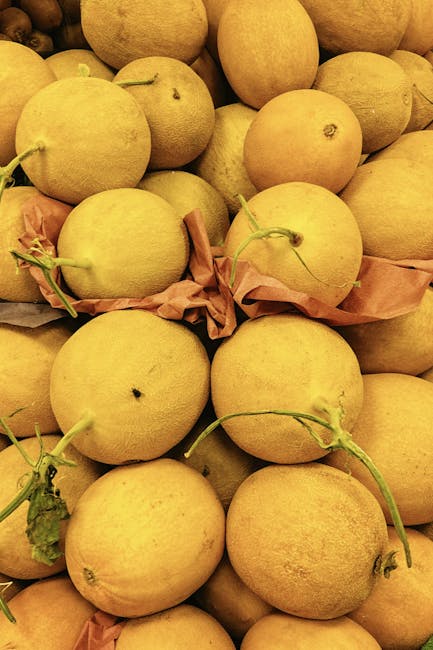Melon Definition: A Comprehensive Guide to Types, Cultivation, and Nutritional Benefits
What is a Melon? A Botanical Definition
Melons, botanically classified as members of the genus Cucumis within the family Cucurbitaceae (the gourd family), are a diverse group of fruiting plants renowned for their sweet, juicy flesh. This family also includes cucumbers, squashes, and pumpkins, highlighting a shared lineage characterized by trailing vines and distinctive fruit structures. The definition of a melon, however, goes beyond simple botanical classification; it encompasses a range of sensory experiences associated with their taste, texture, and aroma. The sweetness varies considerably across different melon varieties, ranging from subtly sweet to intensely sugary. The texture can be crisp and firm or soft and melting, contributing to their versatility in culinary applications.
Types of Melons: A Global Exploration
The world of melons boasts a captivating array of species and cultivars, each possessing unique characteristics. While the term ‘melon’ often evokes images of watermelons and cantaloupes, the reality encompasses a significantly broader spectrum. This diversity stems from centuries of cultivation and adaptation to diverse climates and growing conditions. Here’s a closer look at some prominent melon types:
1. Watermelons (Citrullus lanatus)
Perhaps the most recognizable melon globally, watermelons are characterized by their large, oblong or round shape and vibrant green rind. The flesh is typically a deep red or pink, though yellow varieties also exist. Known for their high water content, they offer refreshing hydration, particularly during hot weather. Watermelons are widely cultivated across diverse regions, reflecting their adaptability and popularity.

2. Cantaloupes (Cucumis melo var. cantalupensis)
Cantaloupes, with their distinctive netted rind and orange-fleshed interior, possess a rich, aromatic sweetness. The texture is often described as firm yet yielding, making them ideal for both fresh consumption and culinary applications. Cantaloupes are prized for their nutritional value, providing a good source of vitamins and antioxidants.
3. Honeydew Melons (Cucumis melo var. inodorus)
Honeydew melons are identifiable by their smooth, pale green rind and sweet, creamy flesh. Unlike cantaloupes, honeydews typically lack the distinct aroma. Their mild sweetness and delicate texture render them versatile ingredients in both sweet and savory dishes.
4. Muskmelons (Cucumis melo)
This is a broader category encompassing several varieties, including cantaloupes and honeydews. Muskmelons are generally characterized by their aromatic fragrance and varied flesh colors, including orange, yellow, and green. The term ‘muskmelon’ refers to the distinctive musky scent emitted by certain varieties.
5. Galia Melons (Cucumis melo var. cantalupensis)
Galia melons are a relatively modern cultivar known for their smooth, pale green skin and sweet, pale green flesh. Their flavour is often described as a unique blend of honeydew and cantaloupe, offering a refreshing alternative to more traditional varieties. They have a slightly firmer texture compared to honeydew melons.
6. Casaba Melons (Cucumis melo var. cantalupensis)
Casaba melons stand out with their smooth, pale yellow or green rind and creamy, white or light green flesh. Their texture is incredibly soft and sometimes described as melting, offering a distinct contrast to the firmer texture of other melon types. Casaba melons have a delicate, sweet flavour.
7. Persian Melons (Cucumis melo var. inodorus)
Often confused with honeydew melons, Persian melons share a similar smooth skin but often exhibit a more oblong shape. Their flesh can vary in color from pale green to almost white, with a delicate and subtly sweet flavour profile.
Melon Cultivation: From Seed to Harvest
Melon cultivation is a fascinating process that requires careful attention to various factors, including climate, soil, and plant care. Melons thrive in warm climates with ample sunlight and well-drained soil. Here are key aspects of growing melons:
1. Soil Preparation:
Melons prefer fertile, well-draining soil rich in organic matter. Soil testing can help determine nutrient deficiencies, allowing for appropriate amendments before planting.
2. Planting:
Melon seeds can be directly sown into the ground after the last frost or started indoors several weeks before transplanting. Adequate spacing between plants is crucial for optimal growth and airflow.
3. Watering:
Consistent watering is essential, especially during fruiting. However, overwatering can lead to root rot, so maintaining well-drained soil is vital.
4. Fertilization:
Regular fertilization provides the nutrients needed for healthy growth and abundant fruit production. Balanced fertilizers are recommended, following package instructions carefully.

5. Pest and Disease Management:
Melons are susceptible to various pests and diseases, including aphids, spider mites, and powdery mildew. Regular monitoring and proactive measures, such as using organic pest control methods, are important.
6. Harvesting:
Melons are ready for harvest when they exhibit characteristics specific to the variety, such as a change in color, a deep aroma, and a slight give when gently squeezed.
Nutritional Benefits of Melons: A Healthy Delight
Melons are not only delicious but also a nutritional powerhouse. They’re a rich source of essential vitamins, minerals, and antioxidants, contributing to overall health and well-being. Key nutritional benefits include:
1. Hydration:
High water content makes melons an excellent source of hydration, particularly beneficial during hot weather.
2. Vitamin C:
Melons, especially cantaloupes, are a good source of vitamin C, a powerful antioxidant crucial for immune function.
3. Vitamin A:
The beta-carotene in melons is converted to vitamin A, essential for vision and skin health.
4. Potassium:
Melons are a good source of potassium, an electrolyte important for maintaining fluid balance and nerve function.
5. Antioxidants:
The antioxidants in melons help protect cells from damage caused by free radicals, reducing the risk of chronic diseases.

Culinary Uses of Melons: Versatile Ingredients
The versatility of melons extends far beyond simply eating them fresh. Their sweet and juicy nature makes them suitable for a wide range of culinary applications, both sweet and savoury.
- Salads: Melons add a refreshing sweetness and juicy texture to salads, complementing savory ingredients.
- Smoothies: Their sweet taste and smooth texture blend seamlessly into refreshing smoothies.
- Desserts: Melons can be used in pies, tarts, sorbets, and ice creams, contributing their natural sweetness.
- Savory Dishes: Some melon varieties, like watermelon, pair surprisingly well with salty and spicy ingredients.
- Garnishes: Melon balls or slices can add a pop of color and flavor to both sweet and savoury dishes.
Conclusion: The Enduring Appeal of Melons
From their botanical classification to their diverse culinary uses and nutritional benefits, melons represent a fascinating and multifaceted group of fruits. Their global appeal speaks volumes about their versatility, deliciousness, and overall contribution to a healthy and balanced diet. Whether enjoyed fresh, incorporated into culinary creations, or explored for their cultivation aspects, the world of melons offers endless possibilities for discovery and enjoyment.




